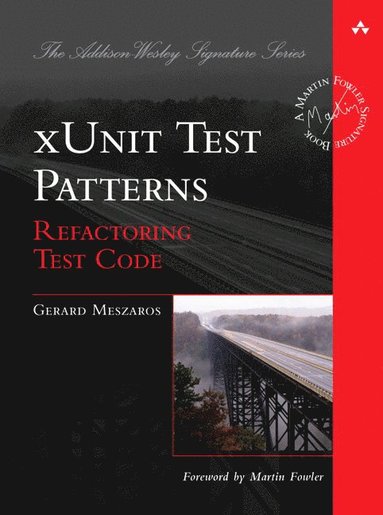
- Format
- Häftad (Paperback)
- Språk
- Engelska
- Antal sidor
- 944
- Utgivningsdatum
- 2007-06-01
- Upplaga
- illustrated ed
- Förlag
- ADDISON-WESLEY
- Illustrationer
- illustrations
- Dimensioner
- 242 x 182 x 50 mm
- Vikt
- Antal komponenter
- 1
- ISBN
- 9780131495050
- 1500 g
xUnit Test Patterns: Refactoring Test Code
Slutsåld
Kundrecensioner
Övrig information
Gerard Meszaros is a Senior Consultant with ClearStream Consulting, Inc., an Alberta-based advanced technology consulting firm. Over the years he has been involved in a wide range of large-scale, corporate-wide projects, offering specialist services and vast experience to some of the most successful organizations worldwide.
Innehållsförteckning
Visual Summary of the Pattern Language xviiForeword xixPreface xxiAcknowledgments xxviIntroduction xxixRefactoring a Test xlvPART I: The Narratives 1 Chapter 1 A Brief Tour 3
About This Chapter 3
The Simplest Test Automation Strategy That Could Possibly Work 3
Development Process 4
Customer Tests 5
Unit Tests 6
Design for Testability 7
Test Organization 7
What's Next? 8
Chapter 2 Test Smells 9About This Chapter 9
An Introduction to Test Smells 9
What's a Test Smell? 10
Kinds of Test Smells 10
What to Do about Smells? 11
A Catalog of Smells 12
The Project Smells 12
The Behavior Smells 13
The Code Smells 16
What's Next? 17
Chapter 3 Goals of Test Automation 19About This Chapter 19
Why Test? 19
Economics of Test Automation 20
Goals of Test Automation 21
Tests Should Help Us Improve Quality 22
Tests Should Help Us Understand the SUT 23
Tests Should Reduce (and Not Introduce) Risk 23
Tests Should Be Easy to Run 25
Tests Should Be Easy to Write and Maintain 27
Tests Should Require Minimal Maintenance as
the System Evolves Around Them 29
What's Next? 29
Chapter 4 Philosophy of Test Automation 31About This Chapter 31
Why Is Philosophy Important? 31
Some Philosophical Differences 32
Test First or Last? 32
Tests or Examples? 33
Test-by-Test or Test All-at-Once? 33
Outside-In or Inside-Out? 34
State or Behavior Verification? 36
Fixture Design Upfront or Test-by-Test? 36
When Philosophies Differ 37
My Philosophy 37
What's Next? 37
Chapter 5 Principles of Test Automation 39About This Chapter 39
The Principles 39
What's Next? 48
Chapter 6 Test Automation Strategy 49About This Chapter 49
What's Strategic? 49
Which Kinds of Tests Should We Automate? 50
Per-Functionality Tests 50
Cross-Functional Tests 52
Which Tools Do We Use to Automate Which Tests? 53
Test Automation Ways and Means 54
Introducing xUnit 56
The xUnit Sweet Spot 58
Which Test Fixture Strategy Do We Use? 58
What Is a Fixture? 59
Major Fixture Strategies 60
Transient Fresh Fixtures 61
Persistent Fresh Fixtures 62
Shared Fixture Strategies 63
How Do We Ensure Testability? 65
Test Last--At Your Peril 65
Design for Testability--Upfront 65
Test-Driven Testability 66
Control Points and Observation Points 66
Interaction Styles and Testability Patterns 67
Divide and Test 71
What's Next? 73
Chapter 7 xUnit Basics 75About This Chapter 75
An Introduction to xUnit 75
Common Features 76
The Bare Minimum 76
Defining Tests 76
What's a Fixture? 78
Definin...
Du kanske gillar
-
Nexus
Yuval Noah Harari
Häftad -
Careless People
Sarah Wynn-Williams
Inbunden -
Doppelganger
Naomi Klein
Häftad
